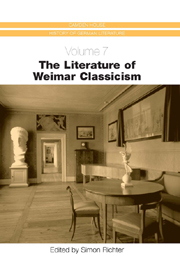Book contents
- Frontmatter
- Contents
- List of Illustrations
- Preface and Acknowledgments
- Conventions, Editions, and Abbreviations
- Introduction
- What is Classicism?
- Antiquity and Weimar Classicism
- The Correspondents' Noncorrespondence: Goethe, Schiller and the Briefwechsel
- Johann Gottfried Herder: The Weimar Classic Back of the (City)Church
- Drama and Theatrical Practice in Weimar Classicism
- German Classical Poetry
- The Novel in Weimar Classicism: Symbolic Form and Symbolic Pregnance
- German Women Writers and Classicism
- Weimar Classicism as Visual Culture
- The Irrelevance of Aesthetics and the De-Theorizing of the Self in “Classical” Weimar
- Goethe's “Classical” Science
- The Political Context of Weimar Classicism
- Bibliography
- Notes on the Contributors
- Index
The Correspondents' Noncorrespondence: Goethe, Schiller and the Briefwechsel
Published online by Cambridge University Press: 05 February 2013
- Frontmatter
- Contents
- List of Illustrations
- Preface and Acknowledgments
- Conventions, Editions, and Abbreviations
- Introduction
- What is Classicism?
- Antiquity and Weimar Classicism
- The Correspondents' Noncorrespondence: Goethe, Schiller and the Briefwechsel
- Johann Gottfried Herder: The Weimar Classic Back of the (City)Church
- Drama and Theatrical Practice in Weimar Classicism
- German Classical Poetry
- The Novel in Weimar Classicism: Symbolic Form and Symbolic Pregnance
- German Women Writers and Classicism
- Weimar Classicism as Visual Culture
- The Irrelevance of Aesthetics and the De-Theorizing of the Self in “Classical” Weimar
- Goethe's “Classical” Science
- The Political Context of Weimar Classicism
- Bibliography
- Notes on the Contributors
- Index
Summary
The Goethe-Schiller correspondence is a monument of Weimar Classicism and a banquet for the student of Weimar culture inasmuch as it records the literary, aesthetic, scientific, editorial, and personal exchanges of the two central figures of the tradition. Beginning in 1794, when Schiller invited Goethe to contribute to a new literary journal, and continuing with frequent, often daily, communications until Schiller's death in 1805, the epistolary collaboration comprises over 1,000 letters that provide a wide range of data, opinions, and ideas not available in any other documentation of the period. Indeed, literary historians have often expressed regret that the two authors occasionally spent time together since these personal encounters resulted in gaps in their thorough and illuminating correspondence that no existing sources can fill. Particularly important and engaging in the collection are the first-hand accounts of writing some of the great works of German literature and also of revising these texts in response or resistance to criticism from the other correspondent. One has, as it were, a glimpse into the poetic workshop of the Weimar Classicists and can follow the genesis of major texts from idea to completion, while witnessing and scrutinizing the process; this is particularly true of Wilhelm Meisters Lehrjahre (Wilhelm Meister's Apprenticeship, 1795/96), which took final shape over roughly eighteen months of epistolary praise, criticism, and haggling.
- Type
- Chapter
- Information
- The Literature of Weimar Classicism , pp. 91 - 112Publisher: Boydell & BrewerPrint publication year: 2005

